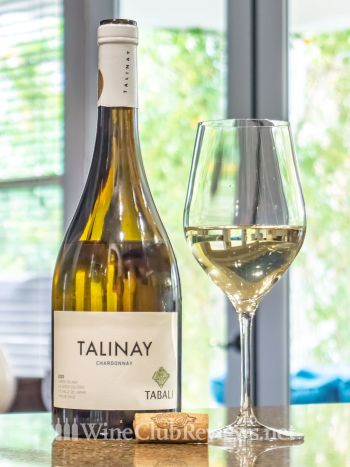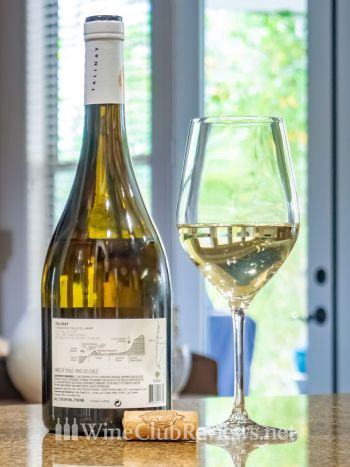Tabalí Talinay Chardonnay Review
What surprised me was how different it tasted than the first time I had it — specifically what had been mouth-puckering and bracing acidity had mellowed into what, I believe, had Decanter Magazine so enamored they gave it 96 points and called it a Wine of the Year.
Wine review by: Jessyca Frederick |


FYI: I find great wine deals so you don’t have to. To keep me on the hunt, I earn a commission when you buy wine based on my recommendations.
About this Wine
Wine: 2020 Talinay Chardonnay
Blend: 100% Chardonnay
Region: Limarí Valley, Chile
Retail price: $21
I consumed it: May 2022
My source: The Decanter Magazine Wine Club by Wine Access
Discover More
From this wine club: The Decanter Magazine Wine Club by Wine Access
From this winery: Tabalí
Region: Chile
Wine color/style: White wine
Grape variety or blend: Chardonnay
Tasting notes: Bright, Lemon, Minerality
Other characteristics: My favorites, Whole cluster, Food friendly
Talinay Chardonnay: What I think
This wine is a Chardonnay made in a Burgundian style, but within Burgundy there are different styles. It is a Chablis-style wine characterized by mineral-driven, saline, lemony citrus bursts, bracing acidity, and a light body. The Chablis style is in stark contrast to the “opulence” of excessive oak and butter popular in Côte de Beaune (also Burgundy) and Napa. There are parts of Santa Barbara County where the geographical and geological makeup reflect that of Chablis (limestone soils, cooler temperatures), and now I’ve learned how the Limarí Valley in Chile is also one of these regions.
Tired of the same old same old, the wine cognoscenti (critics and sommeliers) have turned their attention, and their praise, to this leaner Chablis style (because minimal intervention is also hot and trendy right now). Among other reasons, it is more food friendly.
I had tried this wine a month earlier (different bottle) and I had so many mixed thoughts about it, but I was curious to see what the husband thought as he unfortunately missed this wine on the first go around. (He liked it.)
What surprised me was how different it tasted than the first time I had it — specifically what had been mouth-puckering and bracing acidity had mellowed into what, I believe, had Decanter Magazine so enamored they gave it 96 points and called it a Wine of the Year. Which leads to the key takeaways for this wine:
Not every bottle from the same vintage is identical. The more you try the same wines from the same vintages, that weren't mass-produced to be identical every year, the more obvious this becomes. This phenomena is part of the adventure of wine, brought on by the handcrafted nature of a product made from produce. It’s totally normal and something you’ll likely only ever notice if you’re buying more than one bottle of a given wine at a time.
Chalky, limestone soils make for food-friendly Chardonnay. In the case of this Chilean stunner, the ancient marine soil which lies under the vineyard imparts subtle lemon, floral, and mineral flavors on the palate, propped up by racy acidity. If you read this description but didn’t know the wine hailed from South America, you might just assume it is Chablis. Another new world region embracing this style of Chardonnay shares this soil profile — Sta. Rita Hills in Santa Barbara County, California.
Whole cluster. A winemaking technique generally only available to wineries who harvest by hand, fermenting wine using whole clusters of grapes, stems and all, leads to complexity, balanced acidity, addition of tannins for structure and ageability, and a range of fruit and spice notes that wouldn’t come from the grapes alone.
Restrained use of oak. Chardonnay from California often gets a bad rep for being too oaky. That “classic” Napa Chardonnay style of Rombauer, Far Niente, and Trefethen is actually the classic Côte de Beaune style (premium white Burgundy). While Chardonnay generally gets a lot of oak if the fruit is of poor quality or the winemaker’s intention is to age it for decades, some oak can enhance any Chardonnay. This one saw 10 months in new French Oak barrels, but the oak influence was quite subtle, mostly adding body and not an oaky or vanilla flavor.
Last updated: August 2, 2023
Notice: I hold no formal wine credentials. I am a wine geek who has consumed 1000+ of bottles from 100+ different wine clubs and 1000s more bottles that didn’t come from those wine clubs. I do not accept payment for wine reviews, and I do not accept payments to influence my opinions. I happily accept free wine (and I buy wine).
Why read my wine reviews: Wine taste is subjective. What I like may not be what you like. I try to leave room for you to form your own opinions, so I don’t provide a score or a rating. I do point out wines that are an incredible value or truly not worth the money. I note flaws, wines that don’t have typicity (because this matters if you are buying wine without having tasted it yourself), when wines are out of balance, and when wines lack appropriate body.
I don’t like wasting money (or anything for that matter). I’m careful about where I spend my money and my mindset as a reviewer is to be careful about where you spend yours. I don’t believe a high price tag equals quality and I know for sure there are wines of very good quality that are also a great value.
Learn more about me or get in touch.